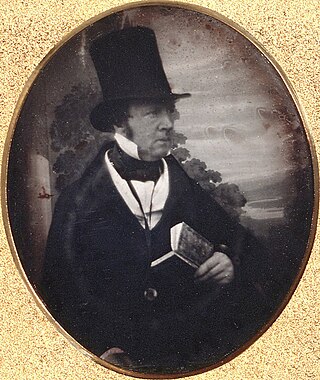
Vibrio cholerae is a species of Gram-negative, facultative anaerobe and comma-shaped bacteria. The bacteria naturally live in brackish or saltwater where they attach themselves easily to the chitin-containing shells of crabs, shrimp, and other shellfish. Some strains of V. cholerae are pathogenic to humans and cause a deadly disease called cholera, which can be derived from the consumption of undercooked or raw marine life species or drinking contaminated water.

William Henry Fox Talbot was an English scientist, inventor, and photography pioneer who invented the salted paper and calotype processes, precursors to photographic processes of the later 19th and 20th centuries. His work in the 1840s on photomechanical reproduction led to the creation of the photoglyphic engraving process, the precursor to photogravure. He was the holder of a controversial patent that affected the early development of commercial photography in Britain. He was also a noted photographer who contributed to the development of photography as an artistic medium. He published The Pencil of Nature (1844–1846), which was illustrated with original salted paper prints from his calotype negatives and made some important early photographs of Oxford, Paris, Reading, and York.
The year 1829 in science and technology involved some significant events, listed below.
The year 1837 in science and technology involved some significant events, listed below.
The year 1841 in science and technology involved some significant events, listed below.
The year 1773 in science and technology involved some significant events.
The year 1884 in science and technology involved some significant events, listed below.
The year 1859 in science and technology involved some significant events, listed below.
The year 1858 in science and technology involved some significant events, listed below.
The year 1852 in science and technology involved some significant events, listed below.

The year 1849 in science and technology involved some significant events, listed below.

Filippo Pacini was an Italian anatomist, posthumously famous for isolating the cholera bacterium Vibrio cholerae in 1854, well before Robert Koch's more widely accepted discoveries 30 years later.

Richard Beard was an English entrepreneur and photographer who vigorously protected his photographic business by litigation over his photographic patents and helped to establish professional photography in the UK.
Events from the year 1854 in the United Kingdom.
Talbot v Laroche (unreported) was an 1854 legal action, pivotal to the history of photography, by which William Fox Talbot sought to assert that Martin Laroche's use of the unpatented, collodion process infringed his calotype patent.
Martin Laroche, born William Henry Silvester, was an early English professional photographer who successfully challenged William Fox Talbot's patent on the calotype and effected a liberalisation in professional practice, research and development that catalysed the development of photography in the nineteenth century.

The Edinburgh Calotype Club of Scotland was the first photographic club in the world. Its members consisted of pioneering photographers primarily from Edinburgh and St Andrews. The efforts of the Club's members resulted in the production of two of the world's earliest assembled photographic albums, consisting of more than 300 images.

Peter Wickens Fry was a pioneering English amateur photographer, although professionally he was a London solicitor. In the early 1850s, Fry worked with Frederick Scott Archer, assisting him in the early experiments of the wet collodion process. He was also active in helping Roger Fenton to set up the Royal Photographic Society in 1853. Several of his photographs are in the Victoria and Albert Museum in London.

Samuel Buckle was an early English photographer.








